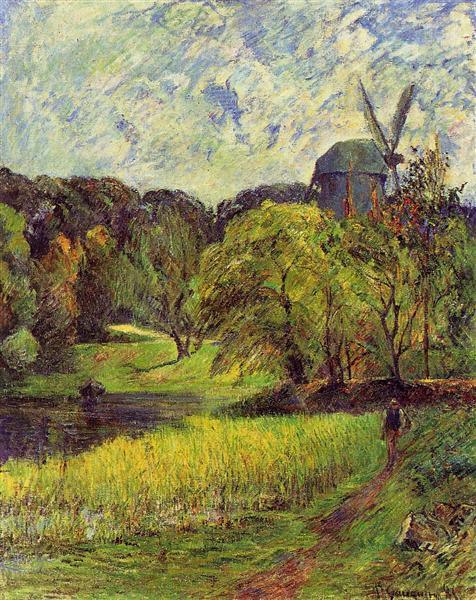Descrição
The painting "The Queen's Mill" (1881) by the famous artist Paul Gauguin is part of a crucial moment in his career, previously marked by his connection to the Impressionist movement and his transition towards a more personal and symbolic style. This work, which represents a landscape characteristic of northern France, is a testament to his ability to capture the atmosphere of a rural scene and his interest in the interaction between the natural environment and the human presence.
Visually, the work presents a windmill that stands majestically, dominating the landscape. Gauguin uses a carefully selected colour palette, where blues and greens predominate, evoking a sense of tranquillity and serenity. The choice of these tones not only describes nature, but also contributes to creating a nostalgic atmosphere that intoxicates the viewer. The robust and bold strokes that characterise Gauguin's work are further emphasised in this work, where the brush technique reveals both the artist's energy and the essence of the landscape.
In "The Queen's Mill", the composition is organised so that the mill becomes the almost undisputed protagonist, while the surrounding elements are placed on a more secondary plane. This reinforces the idea that man and his creation are part of a larger landscape, which, although human, remains an integral part of nature. On the left, we find a human figure that seems to contemplate the mill, another element that highlights the relationship between the individual and the environment. This figure, although small compared to the magnitude of the mill, invites introspection and suggests a silent dialogue between the human being and his environment.
The work also reflects Gauguin's exploration of what he himself called a "synthetic art," where form and color are not limited to the mere representation of the natural world, but seek to invoke feelings and moods. This approach can be traced in Gauguin's later works, where he would delve even further into symbolic and emotional representation, especially during his period in Tahiti. However, in The Queen's Mill, we see an artist still in transition, seeking to distance himself from naturalistic representation to embrace a more subjective vision.
Gauguin is also known for his interest in culture and folklore, elements which he often explores in his work. Although The Queen's Mill does not explicitly reflect exotic or folkloric themes, it can be seen as a precursor to his desire to escape the traditional conventions of European art and explore new narratives in his later works. This painting is therefore a key example of his evolution as an artist.
Finally, within the broader context of the artistic momentum of its time, it is essential to consider how “El Molino de la Reina” relates to contemporary and earlier works. The work stands as a bridge, a moment of reflection on the artist’s introspection, and offers the viewer an invitation to contemplate not only the landscape presented, but also the dialogue established between man, machine and nature.
Through The Queen's Mill, Gauguin not only captures a moment in time, but also opens a window into his emotional and artistic world, offering a glimpse into the rich complexity of his development as one of the pioneers of Post-Impressionist art.
KUADROS ©, a famous painting on your wall.
Hand-made oil painting reproductions, with the quality of professional artists and the distinctive seal of KUADROS ©.
Painting reproduction service with satisfaction guarantee. If you are not completely satisfied with the replica of your painting, we will refund 100% of your money.

